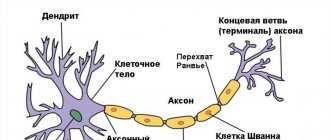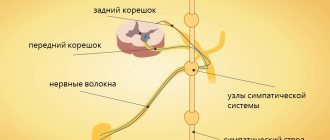A lump in the throat during neurosis is the first signal that malfunctions are occurring in the functioning of the nervous system. Patients who have problems with swallowing and sore throat seek help from many specialists, but few of them associate these symptoms with psychosomatics. “Pharynx neurosis” refers to a pathology that affects the funnel-shaped canal - the link between the mouth and the esophagus.
Where does the feeling of a lump in the throat come from?
The sensation of a lump in the throat is associated with the tone of the vagus nerve.
It is from it that branches extend to the larynx and vocal cords, but in addition to this, also to the dura mater (headache), inner ear (dizziness), heart, bronchi, pharynx muscles, diaphragm, esophagus, stomach, pancreas, liver. Therefore, if there is a violation of the coordination in the work of the nervus vagus, in addition to a lump in the throat and loss of voice, functional disorders in these organs may also appear. The feeling of a foreign body or a sore throat usually coincides in time with a strong experience, hysteria. But this connection may not be clearly visible, and with established neurotic reactions to traumatic situations, a lump in the throat appears on its own.
Causes of the disease
The occurrence of any nervous disease is not one reason, but a combination of them. And throat neurosis is no exception. There are three forms of neurosis: anesthesia, hyperesthesia and paresthesia. All three species have different factors that contribute to the development of the disease.
1. Anesthesia.
Anesthesia of the pharynx is characterized by complete or partial loss of sensitivity and disruption of the swallowing process. The following factors lie at the root of this disease:
- hysteria or severe stress;
- brain tumors;
- all types of paralysis;
- syphilis;
- infections. For example, influenza, measles, diphtheria or typhus;
- problems with the spine. Another reason for the development of pharyngeal neurosis is incorrect posture and osteochondrosis of the cervical spine.
2. Hyperesthesia.
This increases the sensitivity of the throat. Its appearance can be caused by the following reasons:
- throat diseases. This includes tonsillitis, laryngitis and pharyngitis, as well as other inflammatory processes in the trachea, larynx and pharynx;
- bad habits. An unhealthy lifestyle, namely drinking alcohol and smoking, can lead to throat neurosis;
- neurasthenia. A person who is under the influence of severe stress often complains of pain, soreness, scratching and spasm in the throat. These listed symptoms are the main ones in the diagnosis of pharyngeal neurosis.
3. Paresthesia.
It can cause a wide variety of sensations, as in hyperesthesia and anesthesia, but numbness and tingling are added to the clinical picture. The causes are considered to be:
- menopause is the main factor in females;
- suspiciousness. Very often the disease manifests itself in people who are unbalanced and irritable. Based on the form of throat neurosis, the symptoms of the disease are also distinguished.
It is important not to miss other symptoms
The feeling that something is bothering your throat can appear not only with VSD. Therefore, it is important to exclude all other possible causes of this symptom, and only then begin treatment for vegetative-vascular dystonia.
Laryngitis is an inflammation of the throat in the glottis area. Characteristic symptoms of laryngitis are a sore throat, pain when speaking, hoarseness or hoarseness, a dry barking cough, and increased body temperature. The sensation of a foreign body in the throat and soreness during laryngitis is caused by swelling of the glottis. Without proper and timely treatment, swelling can increase dramatically and impair breathing. The diagnosis is confirmed by an otolaryngologist.
In this case of enlargement of the thyroid gland, visible changes are usually observed on the front of the neck (unevenness, bulge or redness), the sensation of a foreign mass in the throat is not associated with emotions or time of day, body weight may change sharply, and the voice becomes rougher over time. An endocrinologist can determine the pathology of the thyroid gland.
Increased stomach acidity and gastroesophageal reflux disease can also cause discomfort in the throat and a feeling of a foreign body. Here the cause will be swelling and spasms that occur in response to the irritating effect of stomach acid. The leading symptom of GERD and high acidity is heartburn. Sore throat, sore throat, and a feeling of coma disappear after starting to take antacids and drugs that reduce the activity of gastric secretion.
Diagnosis of throat neurosis at the Yusupov Hospital
In order to establish the cause of throat neurosis, doctors at the Yusupov Hospital conduct a comprehensive examination of the patient. Using radiography of the cervical spine, osteochondrosis is detected or excluded. More accurate information is obtained after a computed tomography scan of the spine. Patients undergo laboratory tests (general and biochemical blood tests, thyroid hormone levels).
In order to exclude the organic nature of the disease, doctors perform magnetic resonance and computed tomography of the throat. A comprehensive examination includes Doppler ultrasound of the vessels of the brain and neck, and electromyographic study. Patients are consulted by an otolaryngologist, neurologist, vertebrologist, and psychotherapist.
How to get rid of the feeling of a lump in the throat with VSD
In case of excessive nervous excitement, prolonged stress, or a lump in the throat, sedatives help get rid of it. The ones you can buy over the counter without a prescription are based on herbal ingredients or the amino acid glycine. Unlike herbal preparations, glycine improves the nutrition of nervous tissue at the cellular level and does not have a sedative effect - that is, it does not affect the reaction rate. It is approved for pregnant and lactating women, it can be used when driving a car, glycine does not interact with other medications.
Long-term intake of amino acids, which improve cellular respiration, helps to gradually establish normal regulation in vegetative-vascular dystonia, and ultimately relieves a lump in the throat for a long time. The most effective complex is cystine + glycine + glutamic acid in the drug Eltacin®. When these amino acids work together, their effect is significantly enhanced and the healing effect occurs faster.
Relieving throat muscle tension during neurosis
Tension of the throat muscles during neurosis causes breathing problems. In the complex treatment of neurosis of the pharynx and larynx, breathing exercises can give good results. It helps relieve spasm and tension in the respiratory muscles, restore breathing rhythm, reduce the dosage of medications, and speed up the healing process. You need to take an active short breath and a natural passive exhalation. The air should be inhaled through the nose, making a short, strong movement, and exhaled through the mouth.
The breathing movement and inhalation must coincide in time. The rhythm of breathing movements should correspond to the rhythm of the march. Breathing exercises for throat neurosis can be done standing, sitting or lying down. Their effectiveness improves in fresh air. To determine the cause and type of throat neurosis, exclude the organic nature of the disease and undergo a course of effective therapy, call the contact center of the Yusupov Hospital.
Classification
In medicine, pharyngeal neurosis is divided into three types:
- Hyperesthesia - the sensitivity of the throat mucosa is reduced. There is suppression of the swallowing reflex and numbness. Occurs when the central nervous system is damaged, atrophy of the pharyngeal mucosa.
- Hyperesthesia - increased sensitivity, severe pain and discomfort in the throat. Occurs after acute lesions of the pharynx, during long-term neurotic conditions.
- Paresthesia is a feeling of a lump or tickling in the throat caused by altered perception. Often accompanied by hyperesthesia, as a symptom of mental illness, as well as with pathology of the spine in the cervical area.
Causes of an unpleasant lump in the throat
- Overwork.
- Severe or long-term stress. Nervous tension.
- Neuroses and neurotic reactions.
- Depression.
- Anxiety disorder (phobias, panic attacks, generalized anxiety disorder, etc.)
- Psychosomatic diseases.
- Schizotypal disorder, schizophrenia.
- Consequences of organic damage to the nervous system after trauma. infections, strokes, heart attacks, etc.
- Diseases of internal organs (hyperthyroidism, thyroiditis, tonsillitis, spinal osteochondrosis, hiatal hernia, obesity or cachexia).
- Allergic reactions.
- Poisoning.
Diagnostics
Differential diagnosis makes it possible to exclude diseases of the thyroid gland, neoplasms of the neck and pharynx, as processes in which the development of discomfort in the pharynx area is possible. The diagnosis is established through the joint efforts of a neurologist, otorhinolaryngologist and psychiatrist. Mandatory methods of instrumental research include:
MRI of the neck, excluding tumor-like and cystic formations;- pharyngoscopy, with the help of which the mucous membrane of the throat and tonsils is examined, inflammatory diseases and neoplasms of the corresponding area are determined;
- MRI of the brain differentiates brain disorders that act as a primary disease;
- X-ray examination of the cervical spine shows the presence of curvatures, pathologies of the vertebrae and intervertebral discs, and the formation of osteophytes;
- Ultrasound of the thyroid gland excludes enlargement of the gland; sometimes it is necessary to examine the content of the hormones T3, T4, TSH;
- esophagoscopy - determines changes caused by the inflammatory process, ulcerative lesions, and pathological formations.
Psychogenic asthma
In general, bronchial asthma refers to a pathology of the respiratory system. Its development is associated with changes in the structure of the bronchi against the background of immune failures, that is, it is a very specific disease, the etiology of which is not related to mental factors.
People suffering from this disease may develop a condition called psychogenic asthma. This happens when attacks of suffocation, the main symptom of the disease, are provoked by nervous overstrain, both positive and negative, whereas in normal cases this occurs under the influence of cold, infections or physical exertion.
Under the influence of super-emotions, histamine is released. This is one of the main mediators of inflammation. It causes bronchospasm. The result is a dry cough, shortness of breath and an attack of suffocation.
Psychogenic asthma often develops in women during the menstrual period and in children, whose psyche is still quite unstable and very sensitive.
Treatment of pharyngeal neurosis
In therapy, it is important to adhere to an integrated approach with an indispensable cure for the underlying disease. If appropriate symptoms occur, a psychiatrist and an otolaryngologist are involved in the process. If the cause of the condition is determined to be tumors in the brain, the intervention of a neurosurgeon is required. Spinal pathology is corrected by a vertebrologist. A successful result is achieved through the combined use of medication and psychotherapeutic treatment methods.
Psychotherapy consists of helping the patient understand the psychogenic nature of the disease. Only after this can we talk about changing the patient’s attitude towards subjective sensations, learning to relax, and the ability to adequately and kindly accept the surrounding reality.
Medications are prescribed exclusively by a doctor on an individual basis, taking into account the type of neurosis and symptoms. For minor manifestations of a pathological nervous state, sedatives of plant origin are prescribed.
More severe neurological disorders - asthenia, depressive states - require the prescription of antidepressants (fluoxetine, imipramine). During the manifestation of hypochondria and hysteria, it is advisable to use antipsychotics (chlorpromazine, sulpiride).
The duration of the treatment course depends on the severity of the disease - from several months to several years. Auxiliary treatment methods - acupuncture, darsonvalization, electrosleep - help reduce nervousness, improve the quality of sleep and the general condition of the patient. It is necessary to correct emotional stress, establish an optimal work and rest schedule, and avoid stressful situations.
Development of the disease
The root causes of the disease influence the method of formation and course of pharyngeal neurosis. True neurosis occurs against the background of mental abnormalities and characteristics of personal development. They directly depend on the activity of the limbic-reticular system.
Fatigue, infections and nervous stress are provoking factors. Brain structures are responsible for perceiving and processing information coming from receptors. If there are pathologies of the central nervous system, the work of the corresponding structures is disrupted. Most often, a decrease in perception causes anesthesia - a lack of sensitivity. Cervical osteochondrosis provokes the sending of pain impulses along the nerve trunks, forming cervicalgia or radicular syndrome. If the pharyngeal nerves are involved in the process, then pain and paresthesia occur, forming neurosis








